Smart Dust Market Summary, 2032
The global smart dust market was valued at $114.6 million in 2022, and is projected to reach $392.5 million by 2032, growing at a CAGR of 13.1% from 2023 to 2032. Smart dust encompasses a collection of various miniature microelectromechanical systems (MEMS), such as sensors, robots, or other potential devices. These smart dust units can be as tiny as grains of sand or even smaller, typically falling within the range of 20 micrometers up to a millimeter in size. These devices are similar to minicomputers that can sense things in the environment.
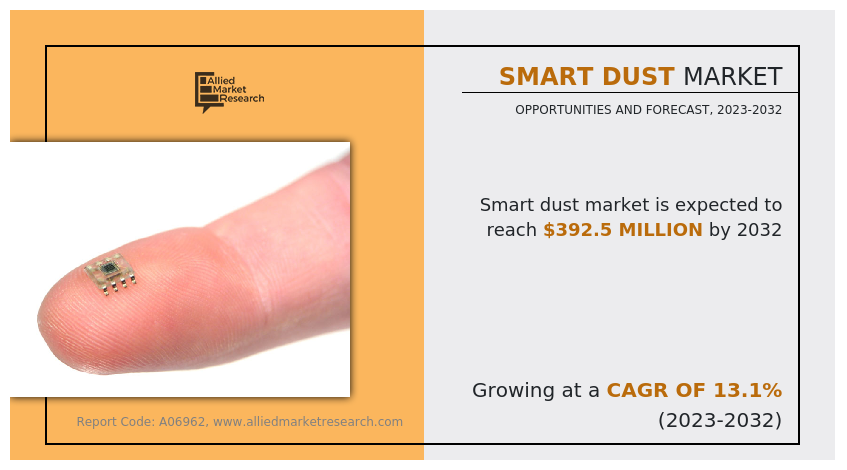 The nodes in this network are called motes, and they have sensors to detect things such as light, temperature, sound, toxins, and vibrations. These motes also have small circuits to do calculations, wireless technology to talk to other devices, and a power source, all packed into a very small package. Even though they're so small, they can communicate wirelessly over a short distance, such as a few millimeters, using a technology called radio-frequency identification (RFID).
The nodes in this network are called motes, and they have sensors to detect things such as light, temperature, sound, toxins, and vibrations. These motes also have small circuits to do calculations, wireless technology to talk to other devices, and a power source, all packed into a very small package. Even though they're so small, they can communicate wirelessly over a short distance, such as a few millimeters, using a technology called radio-frequency identification (RFID).
The potential applications of smart dust are diverse and revolutionary. It can be deployed in various scenarios, such as being carried aloft by hurricane winds to provide data on the storm, embedded into smart city roads to monitor traffic and road conditions, distributed in fire-prone areas to detect fires in early stages, or is used to trigger alarms when detecting critical component damage.
Segment Review
The smart dust market is segmented into Type, Component, Enterprise Size, End-User, and Manufacturing Process.
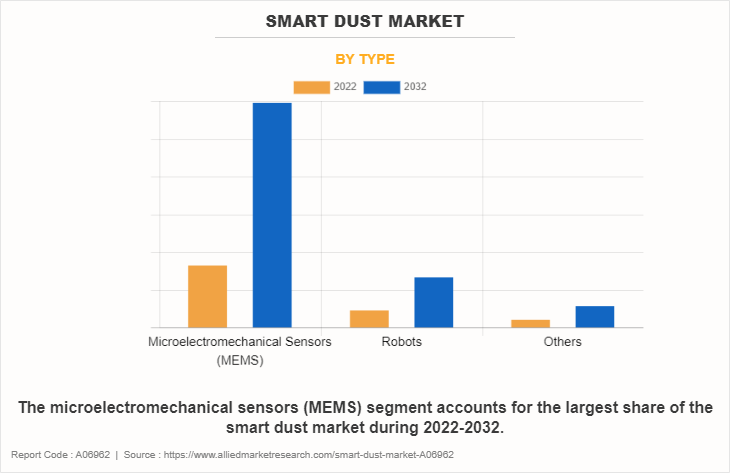
By type, the smart dust market is divided into microelectromechanical sensors, robots, and others.
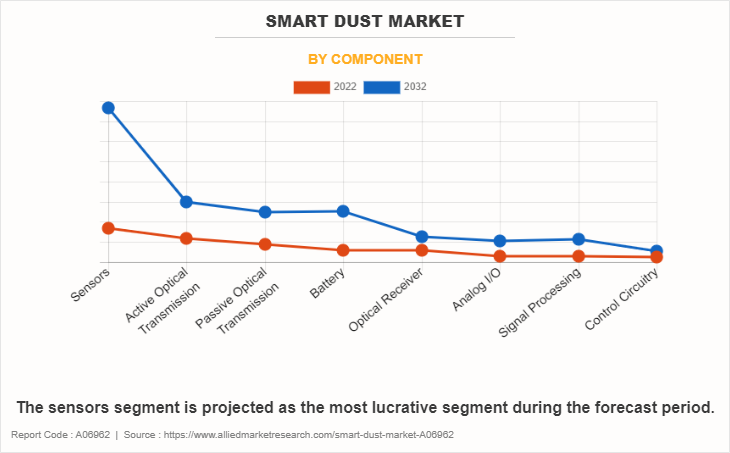
By component, the smart dust market is fragmented into sensors, active optical transmission, passive optical transmission, battery, optical receiver, analog I/O, signal processing, and control circuitry.
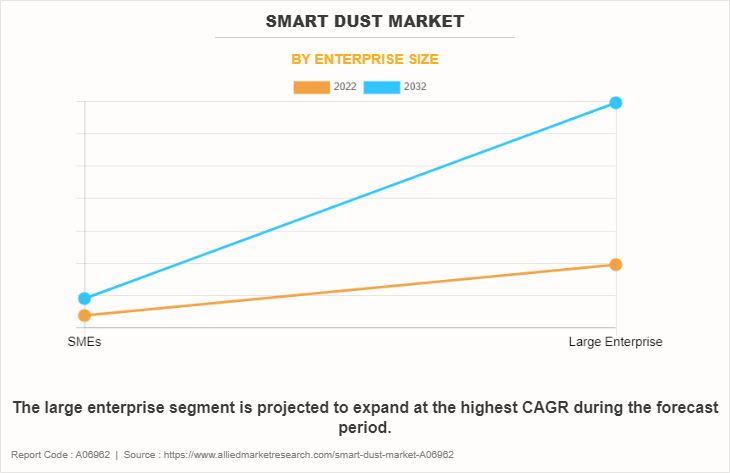
By enterprise size, the smart dust market size is bifurcated into SMEs and large enterprises.
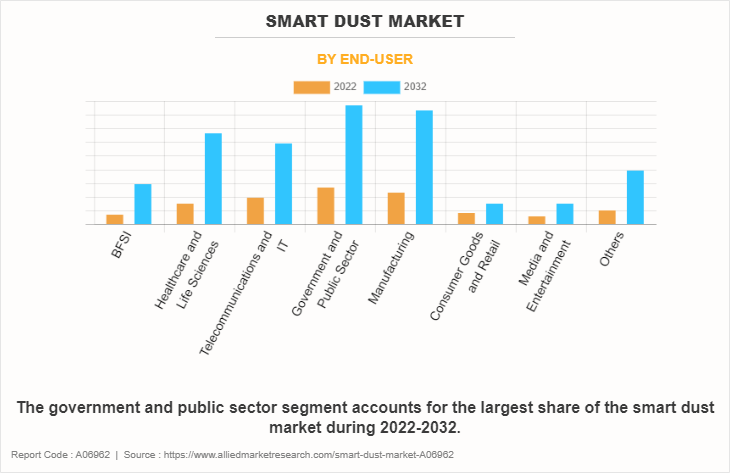
By end-user, the smart dust industry is segregated into BFSI, healthcare & life sciences, telecommunications & IT, government & public sector, manufacturing, consumer goods & retail, media & entertainment, and others.
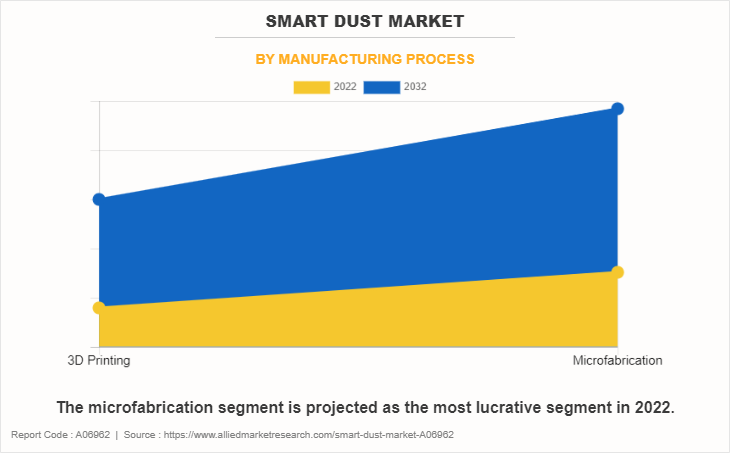
By manufacturing process, the smart dust industry is classified into 3D printing, and microfabrication.
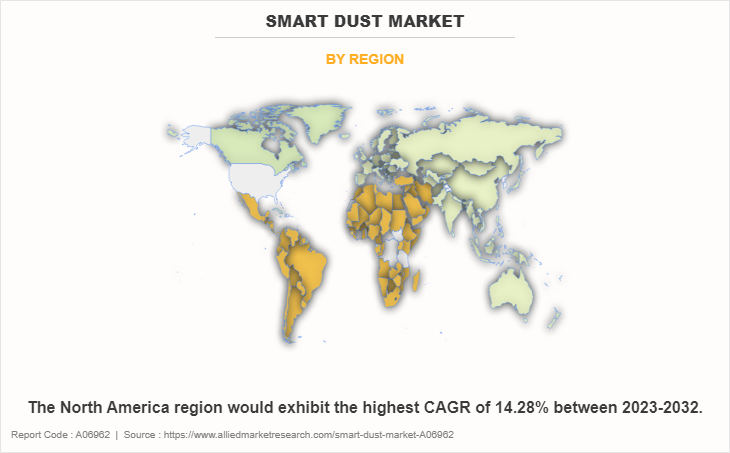
By region, the smart dust market is analyzed across North America (U.S., and Canada), Europe (France, Germany, Italy, Spain, UK, rest of Europe), Asia-Pacific (China, Japan, India, South Korea, Australia, and rest of Asia-Pacific), and LAMEA (Latin America, Middle East, and Africa).
Country-wise, the U.S. has acquired a prime smart dust market share in the North American region and is expected to grow at a significant CAGR during the forecast period of 2023-2032. This dominant position can be attributed to the integration of smart dust technology into defense and security applications.
The adoption of smart dust by the U.S. Department of Defense (DOD) for battlefield surveillance and reconnaissance has resulted in significant investments and partnerships. For instance, as of March 2022, the proposed budget for research and development by the U.S. Department of Defense for 2023 was $130.1 billion.
In Europe, the Germany emerged as the dominant player in terms of revenue share in the smart dust market in 2022, and this trend is expected to continue during the forecast period. UK's emergence as the dominant player in the market in Europe can be attributed to important trends, such as the nation's strong focus on industrial automation and the ongoing advancements in sensor technology.
Germany's expertise in sensor development and miniaturization has been a driving factor for the smart dust market. Collaborations between German research institutes and industry leaders have played a part in advancing sensor capabilities and their use in various sectors such as healthcare and logistics. This cooperation has not only contributed to the growth of the market but has also highlighted Germany's leadership in sensor innovation and integration.
In the Asia-Pacific region, China is anticipated to become a prominent market for smart dust, driven by several significant trends. The government's strong emphasis on technological advancement, along with the quick adoption of Internet of Things (IoT) solutions is propelling the growth.
Furthermore, the integration of smart dust into urban development projects aligns with China's commitment to innovation and sustainable urbanization. China's strategic goal of becoming a global technology leader has resulted in substantial investments in smart dust research and development, fostering partnerships between research institutions and industry players. This strategic approach is fueling the remarkable growth of the smart dust market in China.
In the LAMEA region, Latin America dominated the smart dust market in terms of revenue in 2022. This remarkable growth is driven by the mining industry in countries such as Chile. Smart dust technology holds significant potential for the mining sector, particularly in Chile, where it can revolutionize operations by monitoring the structural integrity of mining facilities and tracking equipment in remote and hazardous areas.
By providing real-time data on conditions and equipment performance, smart dust sensors can enhance safety measures, improve operational efficiency, and prevent potential accidents. This strategic integration of smart dust technology in the mining sector highlights its potential to transform the way mining activities are conducted, safeguarding workers and optimizing mining operations.
One of the most significant advantages of smart dust devices is their extremely small size, allowing them to be placed virtually anywhere, even in narrow and hard-to-reach locations. They operate autonomously with pre-programmed functionality and have their own power supply, requiring minimal human intervention.
The potential applications of smart dust cover a wide range of industries, including environmental monitoring, infrastructure management, healthcare, supply chain monitoring, and defense. The technology holds the potential for ubiquitous autonomous intelligent computation at the end-user level, leading to significant improvements in efficiency, safety, and data gathering.
Similarly, claytronics smart dust is a type of nanotechnology that uses clay particles as the basic building blocks. These particles are small, lightweight, and can be easily manipulated, making them ideal for creating tiny devices. Claytronics smart dust devices can be used for a variety of applications, such as monitoring environmental conditions, tracking the movement of people and objects, and detecting disease.
The potential in environmental monitoring and safety applications drives the adoption of smart dust. With its ability to sense and analyze environmental conditions in real-time, smart dust can play a crucial role in tracking pollution levels, monitoring air and water quality, and detecting potential hazards such as fires and gas leaks. In disaster management, smart dust can be deployed to assess structural health and gather vital data during emergencies.
The versatility and small size of smart dust devices allow them to be placed in various locations, even in hard-to-reach areas, enabling comprehensive and continuous monitoring. As the importance of environmental monitoring and safety measures continues to witness growth, the use of smart dust in these applications is expected to increase, driving its further integration and development in the market.
However, the deployment of smart dust technology presents significant privacy and security concerns due to its omnipresent data collection capabilities. As these tiny sensors can be dispersed almost anywhere, they have the potential to capture sensitive information without individuals' knowledge or consent. To ensure widespread acceptance and prevent misuse, robust measures must be implemented to safeguard data protection and secure communication channels. Strong encryption and authentication protocols should be employed to prevent unauthorized access to the collected data.
Despite this, smart dust presents a promising opportunity for precision farming in agriculture. By deploying smart dust devices, farmers can engage in real-time monitoring of crucial factors such as soil conditions, crop health, and irrigation needs. These miniature sensors placed strategically throughout the farmland can collect and transmit data, providing valuable insights to farmers.
With this data at hand, farmers can optimize their agricultural practices, make informed decisions on irrigation schedules, detect early signs of crop diseases, and efficiently manage resources such as fertilizers and water. Precision agriculture enabled by smart dust can enhance productivity, reduce resource wastage, and promote sustainable farming practices, making it a valuable and transformative opportunity for the agricultural sector.
Top Impacting Factors
The widespread potential applications of smart dust in the medical sector serve as a significant driver for its adoption. This groundbreaking technology enhances medical treatments by closely monitoring internal processes, improving prosthetic fittings, and enabling targeted drug release using nanotechnology. Additionally, smart dust's IoT-based network drives its adoption in industries, where it enhances productivity by predicting machinery failures and optimizing operations with AI and data analytics.
However, the manageability of large quantities of smart dust poses a restraint, challenging its retrieval and control. On the other hand, smart dust introduction for space research presents an opportunity for future space missions, improving high-performance materials and propulsion systems, and advancing space exploration with nanosensors and innovative propulsion concepts.
Competitive Analysis
The smart dust market overview report highlights the highly competitive nature of the market, owing to the strong presence of existing vendors. Vendors with extensive technical and financial resources are expected to gain a competitive advantage over their counterparts by effectively addressing market demands.
The competitive environment in this market is expected to increase as integration strategy adopted by key vendors increase. Competitive analysis and profiles of the major smart dust market players that have been provided in the report include IBM Corporation, Hitachi Ltd., BetaBatt, Inc., Civic Smart, Inc., Valarm LLC, Smartdust Solutions Ltd., Defendec Inc., Cleverciti Systems GmbH, Moog Inc. (Crossbow Technology, Inc.), Epic Semiconductors, Inc.
Key Developments/ Strategies
According to the latest smart dust market forecast, IBM Corporation, Hitachi Ltd., Smartdust Solutions Ltd., BetaBatt, Inc., and Moog Inc. (Crossbow Technology, Inc.) are the top five players in the market. Top market players have adopted various strategies, such as integration to expand their foothold in the market.
In February 2021, Cleverciti has announced its plans to deploy advanced smart parking technology in Redwood City's Central Business District, aimed at facilitating a smoother transition for consumers and commuters returning to the area as the post-COVID-19 pandemic recovery phase commences. This innovative parking technology from Cleverciti is anticipated to play a crucial role in enhancing the overall experience of individuals navigating the district, making their return more convenient and efficient.
Key Benefits For Stakeholders
This report provides a quantitative analysis of the market segments, current trends, estimations, and dynamics of the smart dust market analysis from 2022 to 2032 to identify the prevailing smart dust market opportunity.
The market research is offered along with information related to key drivers, restraints, and opportunities.
Porter's five forces analysis highlights the potency of buyers and suppliers to enable stakeholders make profit-oriented business decisions and strengthen their supplier-buyer network.
In-depth analysis of the smart dust market segmentation assists to determine the prevailing market opportunities.
Major countries in each region are mapped according to their revenue contribution to the global market.
Market player positioning facilitates benchmarking and provides a clear understanding of the present position of the market players.
The report includes the analysis of the regional as well as global smart dust market trends, key players, market segments, application areas, and smart dust market growth strategies.
Smart Dust Market Report Highlights
| Aspects | Details |
| Market Size By 2032 | USD 392.5 million |
| Growth Rate | CAGR of 13.1% |
| Forecast period | 2022 - 2032 |
| Report Pages | 359 |
| By Type |
|
| By Component |
|
| By Enterprise Size |
|
| By End-User |
|
| By Manufacturing Process |
|
| By Region |
|
| Key Market Players | Epic Semiconductors, Inc., Valarm LLC, Moog Inc (Crossbow Technology, Inc.), Smartdust Solutions Ltd., IBM Corporation, Civic Smart, Inc., Hitachi Ltd., BetaBatt, Inc., Cleverciti Systems GmbH, Defendec Inc. |
Analyst Review
The smart dust market is expected to experience substantial growth during the forecast period. This growth can be attributed to several factors, including the increasing demand for innovative technologies in healthcare, industrial monitoring, and space exploration. Smart dust's ability to monitor and analyze critical processes, improve medical treatments, and optimize industrial operations through IoT-based networks and AI integration has garnered significant attention. Moreover, the potential for smart dust to enhance materials and propulsion systems in space research presents lucrative opportunities. These factors, combined with advancements in nanotechnology and its versatile applications, make smart dust a promising technology that is driving market expansion and transformative advancements across various industries.
Some of the key players profiled in the report include IBM Corporation, Hitachi Ltd., BetaBatt, Inc., Civic Smart, Inc., Valarm LLC, Smartdust Solutions Ltd., Defendec Inc., Cleverciti Systems GmbH, Moog Inc (Crossbow Technology, Inc.), Epic Semiconductors, Inc. These players have adopted various strategies to increase their market penetration and strengthen their position in the smart dust industry.
The global smart dust market was valued at $114.6 million in 2022 and is projected to reach $392.5 million by 2032.
The Smart Dust Market is expected to grow at a CAGR of 13.1% from 2023 to 2032
North Americ is the largest regional market for Smart Dust.
The adoption of smart dust in creating smarter cities and improving infrastructure management serves as a significant driver for smart dust market growth.
The top companies holding significant market share in the Smart Dust industry include IBM Corporation, Hitachi Ltd., Smartdust Solutions Ltd., BetaBatt, Inc., and Moog Inc. (Crossbow Technology, Inc.)
Loading Table Of Content...
Loading Research Methodology...



